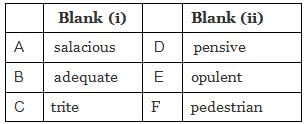GRE Exam > GRE Questions > Direction:For each sentence, choose one word ...
Start Learning for Free
Direction: For each sentence, choose one word for each set of blanks. Select the word or words that best fit(s) the meaning of the sentence as a whole
As a society grows and evolves, so too do its cultural norms. A piece of art or a musical performance that once was viewed as inordinately (i) _____________ may now be seen as utterly (ii) ___________

- a)A,F
- b)B,E
- c)A,D
- d)C,D
- e)C,F
Correct answer is option 'A'. Can you explain this answer?
Verified Answer
Direction:For each sentence, choose one word for each set of blanks. S...
There are no obvious road signs here, so read the sentence carefully for clues to the blanks. The first sentence explains that cultural norms, or what a society views as acceptable, evolve over time. The two blanks describe two different views of the same piece of art, and each blank describes a different extreme, as indicated by “inordinately” (“exceeding limits”) and “utterly” (“to the highest degree”). Note that there’s no way to tell which way the views evolved; they may have gone from acceptable to unacceptable, or vice versa. You’ll have to consider both blanks to find words with the appropriate relationship. The only words that fit are (A) salacious, which means “morally offensive” or “indecent,” and (F) pedestrian, which in this context means “commonplace” or “mundane.” Taken together, they describe how a work of art can at one point be seen as shocking but later be seen as ordinary.
(B) adequate doesn’t fit with “inordinately.” It’s not possible to be extremely adequate—something either is or is not adequate. (C) trite means “boring” or “unoriginal.” This could potentially fit as one part of the comparison, but there’s no appropriately contrasting word for the second blank. (D) pensive means “thoughtful,” and (E) opulent means “lavish” or “luxurious”; neither of these fits into the context of art and cultural norms, and neither contrasts with a choice for the first blank.
Most Upvoted Answer
Direction:For each sentence, choose one word for each set of blanks. S...
There are no obvious road signs here, so read the sentence carefully for clues to the blanks. The first sentence explains that cultural norms, or what a society views as acceptable, evolve over time. The two blanks describe two different views of the same piece of art, and each blank describes a different extreme, as indicated by “inordinately” (“exceeding limits”) and “utterly” (“to the highest degree”). Note that there’s no way to tell which way the views evolved; they may have gone from acceptable to unacceptable, or vice versa. You’ll have to consider both blanks to find words with the appropriate relationship. The only words that fit are (A) salacious, which means “morally offensive” or “indecent,” and (F) pedestrian, which in this context means “commonplace” or “mundane.” Taken together, they describe how a work of art can at one point be seen as shocking but later be seen as ordinary.
(B) adequate doesn’t fit with “inordinately.” It’s not possible to be extremely adequate—something either is or is not adequate. (C) trite means “boring” or “unoriginal.” This could potentially fit as one part of the comparison, but there’s no appropriately contrasting word for the second blank. (D) pensive means “thoughtful,” and (E) opulent means “lavish” or “luxurious”; neither of these fits into the context of art and cultural norms, and neither contrasts with a choice for the first blank.
Free Test
FREE
| Start Free Test |
Community Answer
Direction:For each sentence, choose one word for each set of blanks. S...
There are no obvious road signs here, so read the sentence carefully for clues to the blanks. The first sentence explains that cultural norms, or what a society views as acceptable, evolve over time. The two blanks describe two different views of the same piece of art, and each blank describes a different extreme, as indicated by “inordinately” (“exceeding limits”) and “utterly” (“to the highest degree”). Note that there’s no way to tell which way the views evolved; they may have gone from acceptable to unacceptable, or vice versa. You’ll have to consider both blanks to find words with the appropriate relationship. The only words that fit are (A) salacious, which means “morally offensive” or “indecent,” and (F) pedestrian, which in this context means “commonplace” or “mundane.” Taken together, they describe how a work of art can at one point be seen as shocking but later be seen as ordinary.
(B) adequate doesn’t fit with “inordinately.” It’s not possible to be extremely adequate—something either is or is not adequate. (C) trite means “boring” or “unoriginal.” This could potentially fit as one part of the comparison, but there’s no appropriately contrasting word for the second blank. (D) pensive means “thoughtful,” and (E) opulent means “lavish” or “luxurious”; neither of these fits into the context of art and cultural norms, and neither contrasts with a choice for the first blank.

|
Explore Courses for GRE exam
|

|
Question Description
Direction:For each sentence, choose one word for each set of blanks. Select the word or words that best fit(s) the meaning of the sentence as a wholeAs a society grows and evolves, so too do its cultural norms. A piece of art or a musical performance that once was viewed as inordinately (i) _____________ may now be seen as utterly (ii) ___________a)A,Fb)B,Ec)A,Dd)C,De)C,FCorrect answer is option 'A'. Can you explain this answer? for GRE 2025 is part of GRE preparation. The Question and answers have been prepared according to the GRE exam syllabus. Information about Direction:For each sentence, choose one word for each set of blanks. Select the word or words that best fit(s) the meaning of the sentence as a wholeAs a society grows and evolves, so too do its cultural norms. A piece of art or a musical performance that once was viewed as inordinately (i) _____________ may now be seen as utterly (ii) ___________a)A,Fb)B,Ec)A,Dd)C,De)C,FCorrect answer is option 'A'. Can you explain this answer? covers all topics & solutions for GRE 2025 Exam. Find important definitions, questions, meanings, examples, exercises and tests below for Direction:For each sentence, choose one word for each set of blanks. Select the word or words that best fit(s) the meaning of the sentence as a wholeAs a society grows and evolves, so too do its cultural norms. A piece of art or a musical performance that once was viewed as inordinately (i) _____________ may now be seen as utterly (ii) ___________a)A,Fb)B,Ec)A,Dd)C,De)C,FCorrect answer is option 'A'. Can you explain this answer?.
Direction:For each sentence, choose one word for each set of blanks. Select the word or words that best fit(s) the meaning of the sentence as a wholeAs a society grows and evolves, so too do its cultural norms. A piece of art or a musical performance that once was viewed as inordinately (i) _____________ may now be seen as utterly (ii) ___________a)A,Fb)B,Ec)A,Dd)C,De)C,FCorrect answer is option 'A'. Can you explain this answer? for GRE 2025 is part of GRE preparation. The Question and answers have been prepared according to the GRE exam syllabus. Information about Direction:For each sentence, choose one word for each set of blanks. Select the word or words that best fit(s) the meaning of the sentence as a wholeAs a society grows and evolves, so too do its cultural norms. A piece of art or a musical performance that once was viewed as inordinately (i) _____________ may now be seen as utterly (ii) ___________a)A,Fb)B,Ec)A,Dd)C,De)C,FCorrect answer is option 'A'. Can you explain this answer? covers all topics & solutions for GRE 2025 Exam. Find important definitions, questions, meanings, examples, exercises and tests below for Direction:For each sentence, choose one word for each set of blanks. Select the word or words that best fit(s) the meaning of the sentence as a wholeAs a society grows and evolves, so too do its cultural norms. A piece of art or a musical performance that once was viewed as inordinately (i) _____________ may now be seen as utterly (ii) ___________a)A,Fb)B,Ec)A,Dd)C,De)C,FCorrect answer is option 'A'. Can you explain this answer?.
Solutions for Direction:For each sentence, choose one word for each set of blanks. Select the word or words that best fit(s) the meaning of the sentence as a wholeAs a society grows and evolves, so too do its cultural norms. A piece of art or a musical performance that once was viewed as inordinately (i) _____________ may now be seen as utterly (ii) ___________a)A,Fb)B,Ec)A,Dd)C,De)C,FCorrect answer is option 'A'. Can you explain this answer? in English & in Hindi are available as part of our courses for GRE.
Download more important topics, notes, lectures and mock test series for GRE Exam by signing up for free.
Here you can find the meaning of Direction:For each sentence, choose one word for each set of blanks. Select the word or words that best fit(s) the meaning of the sentence as a wholeAs a society grows and evolves, so too do its cultural norms. A piece of art or a musical performance that once was viewed as inordinately (i) _____________ may now be seen as utterly (ii) ___________a)A,Fb)B,Ec)A,Dd)C,De)C,FCorrect answer is option 'A'. Can you explain this answer? defined & explained in the simplest way possible. Besides giving the explanation of
Direction:For each sentence, choose one word for each set of blanks. Select the word or words that best fit(s) the meaning of the sentence as a wholeAs a society grows and evolves, so too do its cultural norms. A piece of art or a musical performance that once was viewed as inordinately (i) _____________ may now be seen as utterly (ii) ___________a)A,Fb)B,Ec)A,Dd)C,De)C,FCorrect answer is option 'A'. Can you explain this answer?, a detailed solution for Direction:For each sentence, choose one word for each set of blanks. Select the word or words that best fit(s) the meaning of the sentence as a wholeAs a society grows and evolves, so too do its cultural norms. A piece of art or a musical performance that once was viewed as inordinately (i) _____________ may now be seen as utterly (ii) ___________a)A,Fb)B,Ec)A,Dd)C,De)C,FCorrect answer is option 'A'. Can you explain this answer? has been provided alongside types of Direction:For each sentence, choose one word for each set of blanks. Select the word or words that best fit(s) the meaning of the sentence as a wholeAs a society grows and evolves, so too do its cultural norms. A piece of art or a musical performance that once was viewed as inordinately (i) _____________ may now be seen as utterly (ii) ___________a)A,Fb)B,Ec)A,Dd)C,De)C,FCorrect answer is option 'A'. Can you explain this answer? theory, EduRev gives you an
ample number of questions to practice Direction:For each sentence, choose one word for each set of blanks. Select the word or words that best fit(s) the meaning of the sentence as a wholeAs a society grows and evolves, so too do its cultural norms. A piece of art or a musical performance that once was viewed as inordinately (i) _____________ may now be seen as utterly (ii) ___________a)A,Fb)B,Ec)A,Dd)C,De)C,FCorrect answer is option 'A'. Can you explain this answer? tests, examples and also practice GRE tests.

|
Explore Courses for GRE exam
|

|
Signup for Free!
Signup to see your scores go up within 7 days! Learn & Practice with 1000+ FREE Notes, Videos & Tests.























